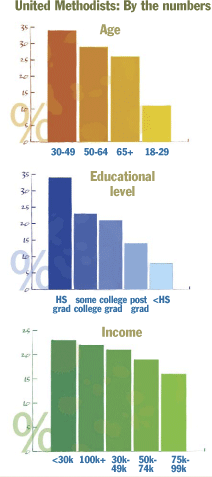
Editorial: Possibilities prevail in changing religious landscape
I believe in hope - always. Sometimes, I also believe in mercy killing. Mine is a practical, work-day kind of optimism.
There is, for example, part of me that always sees the proverbial glass as half-full. But another part of me, rather than finding it half-empty, wonders if it's not time for a new glass - one that's the right size, one that best fits the situation in which a glass is needed.
The recently released U.S. Religious Landscape Survey, by the Pew Forum on Religion and Public Life, makes me feel this way.
This landmark, 150-page study of religion in America, found that nearly half of Americans have left the faith tradition of their upbringing, switching to a different religious tradition or leaving the organized church altogether.
Of the 53 percent who left the Methodist faith tradition of their childhood, the survey reports that 19 percent changed to evangelical churches, 11 percent to other mainline Protestant churches and 3 percent to historically black churches that are not Methodist. An alarming 12 percent say they are no longer part of any faith group and 8 percent moved to a non-Protestant religion.
The statistic I find interesting is that 16 percent of Americans have no religious affiliation. They don't claim to be agnostics or atheists, rather they are people who don't find their identity in any denominational or religious label.
This feels like a culture shift from what's been called a "fixed" identity to a "fluid" one.
This shift is responsible for the emerging church movement. It's also being felt in various ways in almost every United Methodist church in this region as tremors of uncertainty shake the foundation of "the way we've always done things."
For the pessimist, finding the church's inability to respond to people viewing church selection as "a vibrant marketplace," in which personal choices supersede tradition, is seen in declining demographics.
A few years back, according to Good News Magazine, the Council of Bishops reported that 41 percent of United Methodist churches had no membership gains the previous year.
"There is no future for The United Methodist Church in the United States unless we can reach more people, younger people and more diverse people," the Rev. Lovett Weems of the Lewis Center for Church Leadership at Wesley Seminary told the United Methodist News Service.
 "It's not that we're not making the efforts or spending the money to reach younger and more diverse people, but we're not focusing our efforts on outcomes," Weems said.
"It's not that we're not making the efforts or spending the money to reach younger and more diverse people, but we're not focusing our efforts on outcomes," Weems said.
However, in an interview in Forbes magazine, Weems was more optimistic, noting that increasingly, "growing churches have a clear sense of identity and meet people's needs in a changing culture."
As Methodists, this focus on the mission of making disciples is in our DNA.
Taylor Burton-Edwards, of the General Board of Discipleship, writes about this in his blog.
"John Wesley was a terrible parish priest," Taylor-Edwards pointed out.
Wesley lacked tact and patience and "if he were being evaluated for pastoral excellence in his own day, he would have been an unmitigated failure."
But fortunately, the founder of Methodism found other outlets to preach, teach, serve and evangelize.
Wesley, Burton-Edwards wrote, did not try to replace the existing congregations in England. Rather, "he was trying to find a way to change people's lives - so they actually lived every day what they confessed on Sunday morning."
That's the direction the survey of the religious landscape points the church toward. It's not a matter of the pew being half full or half empty. It's about changing the focus from how people act in the pews to what they feel and do once they leave them.

Login/Register to leave comment